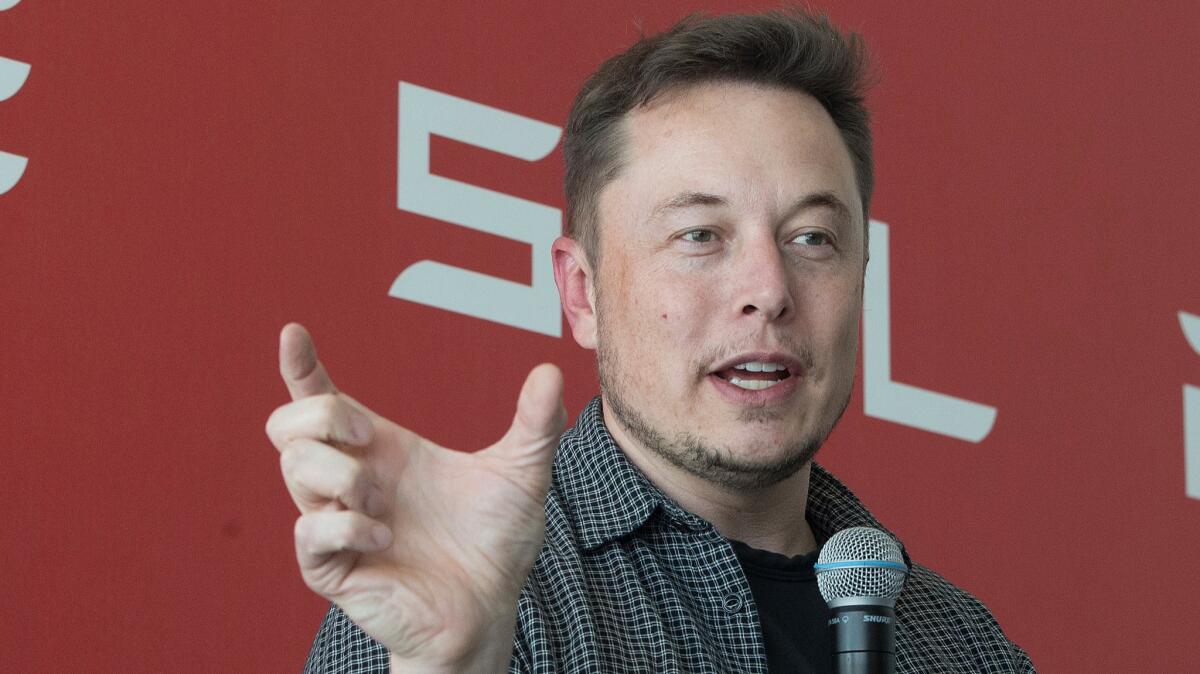Tesla’s Autopilot shift to radar might have saved the life of driver in Model S crash, Elon Musk says

Elon Musk speaks at Tesla Motors’ giant battery factory outside Reno in July.
Tesla Chief Executive Elon Musk revealed what he called “dramatic improvements” to the automaker’s Autopilot technology Sunday that shift it to rely primarily on radar — and not just cameras — to help the car see better and avoid collisions.
The announcement follows several Autopilot-related crashes, including a fatal Florida accident in May in which a Tesla Model S driving on Autopilot slammed into a big rig after apparently failing to distinguish between the white truck and the bright sky behind it.
Musk said he believes the improvements will make his cars “by far” the safest on the road and probably would have saved the life of Joshua Brown, who died in the Florida crash.
But Musk cautioned that the Autopilot 8.0 update “does not mean perfect safety,” he said Sunday. “Perfect safety is really an impossible goal.”
The improvements come as the National Highway Traffic Safety Administration is investigating the fatal crash and amid criticism that Musk rolled out Autopilot to customers in beta trials before the technology had been fully tested.
One of the new upgrades is “Autosteer,” which will force drivers to pay attention. The car will repeatedly warn drivers to keep their hands on the steering wheel. If those warnings are ignored, the driver will have to park the car to re-engage the self-driving program.
Musk said Sunday that Tesla has shared most of the changes with NHTSA officials, who, according to the chief executive, had a “quite positive” reaction. “They appear very happy with the changes,” he told reporters.
Karl Brauer, a senior analyst at Kelley Blue Book, said the changes should reduce some of the problems drivers have reported with Autopilot, including cars in the right lane on a freeway drifting toward an exit, even when the driver doesn’t wish to leave the road.
“With these enhancements, Autopilot will be closer to working as people expected it to work in the first place,” Brauer said. “It wouldn’t be a cure-all and a complete fix for every circumstance a Tesla ever encounters. [But] it should be less likely to make mistakes than it used to.”
The Autopilot feature includes machine steering, collision avoidance, assisted lane changing and adaptive cruise control. On a well-marked highway, the car can nearly drive itself, although the human driver is expected to remain alert and take over the controls when necessary.
The changes will take effect in one to two weeks and will be a software upgrade that won’t require owners to bring their cars into a shop, Musk said.
The most significant upgrade, Musk said, is shifting Autopilot to rely on the car’s radar to create “a picture of the world.”
The radar was added to Tesla cars in October 2014, but was designed to only supplement the camera and image-processing system.
“After careful consideration, we now believe it can be used as a primary control sensor without requiring the camera to confirm visual image recognition,” Musk said in a blog post published Sunday after the call.
The change is counterintuitive, Musk said, “because of how strange the world looks in radar.”
People, for example, look partially translucent on radar. Something wooden or painted plastic is almost as transparent as glass to radar, he said. Any metallic surface can look bigger than it really is.
“The big problem in using radar to stop the car is avoiding false alarms,” Musk said in his post. “Slamming on the brakes is critical if you are about to hit something large and solid, but not if you are merely about to run over a soda can. Having lots of unnecessary braking events would at best be very annoying and at worst cause injury.”
Musk said the new software will receive more data points from the radar and that the radar snapshots would be assembled every tenth of a second to create a 3-D picture.
“By comparing several contiguous frames against vehicle velocity and expected path, the car can tell if something is real and assess the probability of collision,” Musk said in the post.
More Teslas on the road — and more miles logged using Autopilot — should improve the technology and safety over time through “fleet learning,” Musk said. He estimated that a car on Autopilot will be about three times safer than a normal car.
While the enhancements are “meaningful,” they are limited because Musk can only update the software, not add additional sensors, without undergoing an enormously costly recall, analyst Brauer said.
“He’s doing everything realistically possible and economically possible,” he said.
In the wake of the Florida crash, the Center for Auto Safety had urged Tesla to issue a recall and disable the Autopilot function until NHTSA issues safety guidelines. The agency is developing regulations for autonomous vehicles and is expected to provide more details in the coming weeks.
ALSO
Elon Musk: Launch pad explosion is ‘most difficult and complex’ failure in SpaceX’s 14 years
Samsung warns customers to stop using Galaxy Note 7 immediately; more fires reported
UPDATES:
2:38 p.m.: This article was updated with comments from Kelley Blue Book senior analyst Karl Brauer.
12:40 p.m.: This article was updated with additional details.
12:20 p.m., Sept. 11: This post was updated with details from Elon Musk’s announcement.
This article was originally published Sept. 10.
More to Read
Inside the business of entertainment
The Wide Shot brings you news, analysis and insights on everything from streaming wars to production — and what it all means for the future.
You may occasionally receive promotional content from the Los Angeles Times.










